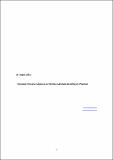Por favor, use este identificador para citar o enlazar a este item:
http://hdl.handle.net/10261/223089COMPARTIR / EXPORTAR:
 SHARE SHARE
 CORE
BASE CORE
BASE
|
|
| Visualizar otros formatos: MARC | Dublin Core | RDF | ORE | MODS | METS | DIDL | DATACITE | |

| Título: | Investigative monitoring of pesticide and nitrogen pollution sources in a complex multi-stressed catchment: The lower Llobregat River basin case study (Barcelona, Spain) |
Autor: | Postigo, Cristina CSIC ORCID ; Ginebreda Martí, Antoni CSIC ORCID; Barbieri, Maria Vittoria CSIC ORCID CVN; Barceló, Damià CSIC ORCID; Martín-Alonso, Jordi; Cal, Agustina de la CSIC; Boleda, M. Rosa; Otero, Neus CSIC ORCID; Carré, Raúl; Solà, Vinyet; Queralt, Enric; Isla, Elena; Casanovas, Anna; Frances, Gemma; López de Alda, Miren CSIC ORCID | Palabras clave: | Water pollution Nitrate Ammonium Stable isotopes Agriculture Plant protection products |
Fecha de publicación: | 10-feb-2020 | Editor: | Elsevier | Citación: | Science of the Total Environment 755:142377 (2021) | Resumen: | The management of the anthropogenic water cycle must ensure the preservation of the quality and quantity of water resources and their careful allocation to the different uses. Protection of water resources requires the control of pollution sources that may deteriorate them. This is a challenging task in multi-stressed catchments. This work presents an approach that combines pesticide occurrence patterns and stable isotope analyses of nitrogen (δ15N-NO3−, δ15N-NH4+), oxygen (δ18O-NO3−), and boron (δ11B) to discriminate the origin of pesticides and nitrogen-pollution to tackle this challenge. The approach has been applied to a Mediterranean sub-catchment subject to a variety of natural and anthropogenic pressures. Combining the results from both analytical approaches in selected locations of the basin, the urban/industrial activity was identified as the main pressure on the quality of the surface water resources, and to a large extent also on the groundwater resources, although agriculture may play also an important role, mainly in terms of nitrate and ammonium pollution. Total pesticide concentrations in surface waters were one order of magnitude higher than in groundwaters and believed to originate mainly from soil and/or sediments desorption processes and urban and industrial use, as they were mainly associated with treated wastewaters. These findings were supported by the stable isotope results that pointed to an organic origin of nitrate in surface waters and most groundwater samples. Ammonium pollution observed in some aquifer locations is probably generated by nitrate reduction. Overall, no significant attenuation processes could be inferred for nitrate pollution. The approach presented here exemplifies the investigative monitoring envisioned in the Water Framework Directive. | Versión del editor: | https://doi.org/10.1016/j.scitotenv.2020.142377 | URI: | http://hdl.handle.net/10261/223089 | DOI: | 10.1016/j.scitotenv.2020.142377 |
| Aparece en las colecciones: | (IDAEA) Artículos |
Ficheros en este ítem:
| Fichero | Descripción | Tamaño | Formato | |
|---|---|---|---|---|
| Postigo et al_revised_080920_repositorio.pdf | Artículo principal | 1,85 MB | Adobe PDF |  Visualizar/Abrir |
| Supplementary_revised 080920_repositorio.pdf | Material suplementario | 1,84 MB | Adobe PDF |  Visualizar/Abrir |
CORE Recommender
SCOPUSTM
Citations
38
checked on 16-abr-2024
WEB OF SCIENCETM
Citations
28
checked on 24-feb-2024
Page view(s)
140
checked on 23-abr-2024
Download(s)
153
checked on 23-abr-2024
Google ScholarTM
Check
Altmetric
Altmetric
NOTA: Los ítems de Digital.CSIC están protegidos por copyright, con todos los derechos reservados, a menos que se indique lo contrario.
